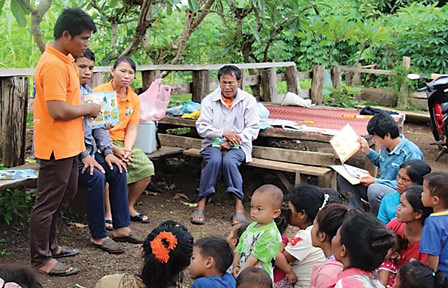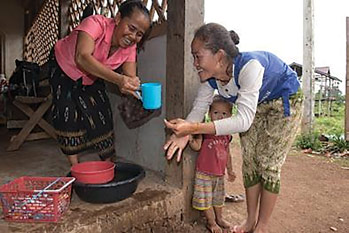Converging for Nutrition
Lao PDR has achieved impressive economic growth in the past two years and the poverty ratio has fallen by nearly 10% in the past decade. The Government of Laos is now tackling its high levels of food insecurity and malnutrition to achieve a decline in stunting of a minimum of 3.9% points per year to get on track for related MDG 1 targets.
[vc_row row_type=”row” text_align=”left” css_animation=””][vc_column width=”1/2″]

Converging is just like multi-sectoral coordination and is not easy. The who, when, how and what of the coordination process needs to be defined – no one size fits all.
Chandavone Phoxay MD, MSc, PhD, Deputy Director General, Hygiene Health Promotion Department, Ministry of Health and SUN Government Focal Point with contribution from Dr. Bounfeng Phommalaysith Deputy Director General, Cabinet MoH, Stefania Dina, IFAD Country Coordinator, and IFAD team to Lao P.D.R[/vc_column_text][/vc_column][/vc_row][vc_row row_type=”row” text_align=”left” css_animation=””][vc_column][vc_separator type=”transparent”][/vc_column][/vc_row][vc_row row_type=”row” text_align=”left” css_animation=””][vc_column][vc_column_text custom_options=””]Lao PDR has achieved impressive economic growth in the past two years and the poverty ratio has fallen by nearly 10% in the past decade. The Government of Laos is now tackling its high levels of food insecurity and malnutrition to achieve a decline in stunting of a minimum of 3.9% points per year to get on track for related MDG 1 targets.[/vc_column_text][/vc_column][/vc_row][vc_row row_type=”row” text_align=”left” css_animation=””][vc_column][vc_separator type=”transparent”][/vc_column][/vc_row][vc_row row_type=”row” text_align=”left” css_animation=””][vc_column][vc_column_text custom_options=””]
A strong political commitment
The political commitment in Lao PDR is strong at the highest level in government and in parliament, with commitment to ending malnutrition that is reflected in the many actions that have been undertaken. Such actions include:
- the implementation of the National Nutrition Policy (NNP)
- the National Nutrition Strategy and Action Plan (NNSAP) 2010-2015
- prioritization of interventions of the multisectoral plan on nutrition in 2013 Î an increase of the entire health sector budget (including nutrition-specific and nutritionsensitive interventions) to 9% of the total Government expenditure since 2012
- the reduction of malnutrition is a major priority in the eighth National Social and Economic Development Plan of the country
- and the Government of Laos has made significant efforts to establish a multi-sectoral committee on nutrition – National Nutrition Committee (NNC) and its Secretariat in July 2013. The Committee aims to ensure
continuity of increasing investment in nutrition, establishing all the institutional arrangements and modalities needed to address the problems on food and nutrition security.
 [/vc_column_text][/vc_column][/vc_row][vc_row row_type=”row” text_align=”left” css_animation=””][vc_column][vc_separator type=”transparent”][/vc_column][/vc_row][vc_row row_type=”row” text_align=”left” css_animation=””][vc_column][vc_column_text custom_options=””]
[/vc_column_text][/vc_column][/vc_row][vc_row row_type=”row” text_align=”left” css_animation=””][vc_column][vc_separator type=”transparent”][/vc_column][/vc_row][vc_row row_type=”row” text_align=”left” css_animation=””][vc_column][vc_column_text custom_options=””]
Government advocacy for multi-sectoral engagement
The health sector strongly advocated to the Government of Laos and relevant line ministries on nutrition, making the case that nutrition is a multisectoral issue that requires a multi-sectoral solution. One sector or one organisation alone cannot tackle this problem. As a result, the Government recognised the importance of significant involvement of national, sub-national and peripheral levels and the engagement of multiple sectors, beyond health, for combating food and nutrition insecurity in the country. It is emphasised at all levels that other disciplines can be involved to help scale up nutrition-specific and sensitive interventions by working closely with all the concerned sectors and in making the efforts sustainable. Engaging at an international level, Lao PDR officially joined the Scaling Up Nutrition (SUN) Movement in April 2011, with the Ministry of Health (MoH) nominated as the SUN focal point within the Government.[/vc_column_text][/vc_column][/vc_row][vc_row row_type=”row” text_align=”left” css_animation=””][vc_column][vc_separator type=”transparent”][/vc_column][/vc_row][vc_row row_type=”row” text_align=”left” css_animation=””][vc_column][vc_column_text custom_options=””]
Inter-ministerial coordination mechanism
The NNC Secretariat is chaired by Vice-Minister of Health and co-chaired by the Vice-Ministers of Agriculture and Forestry, of Education and Sport and of Planning and Investment. The NNC includes relevant ministries: Health, Agriculture-Forestry, Education, Planning (Investment), Commerce, Finance, National Poverty Eradication and Rural Development Committee, National Commission for Mother and Child, mass organizations and other relevant line ministries.

The NNC Secretariat is chaired by Vice-Minister of Health and co-chaired by the Vice-Ministers of Agriculture and Forestry and of Planning and Investment. The Secretariat is technically assisted and coordinated by a core team which comprises 5 key ministries, including health, agriculture-forestry, education, planning-investment and poverty eradication and rural development. As the focal point, the MoH acts as the centre of coordination among multiple sectors and development partners on nutrition. There are 5 Technical Working Groups (TWGs) which act as a core team, including TWGs on food security, (under agricultural sector), nutrition (under health sector), education (under education sector), Secretariat of Round Table (under planning and investment sector) and Secretariat of Rural Development and Poverty Eradication Committee.
The core team members play an articulation role with the respective sectors for following up the recommendations of the NNC and the Secretariat.

- At central level:
a. alignment of implementation of interventions from different sectors with the multi-sectoral plan
b. mobilisation of internal and external funds
c. close monitoring of the implementation
d. and reporting to the respective sector and NNC secretariat.
- The provincial and district levels will implement the 22 interventions of the multi-sectoral plan, conduct microplanning, review and scale up the existing interventions, define gaps and report to each of the sector, the provincial secretariat and the central level.
As a recent initiative, the core team together with TWG-FSC and nutrition is developing a Common Results Framework and designing the effective mechanism for information management, monitoring and evaluation and reporting the progress of the multi-sectoral plan.[/vc_column_text][/vc_column][/vc_row][vc_row row_type=”row” text_align=”left” css_animation=””][vc_column][vc_separator type=”transparent”][/vc_column][/vc_row][vc_row row_type=”row” text_align=”left” css_animation=””][vc_column][vc_column_text custom_options=””]
Decentralising the process
In addition to the establishment of the NNC, the Ministry of Agriculture and Forestry (MAF) and the MoH have initiated the decentralisation of the coordination process with support from the Agriculture and Health Sector Working Groups. The establishment of a secretariat for the Provincial Nutrition Committee in the target provinces replicating the national-level structure aims at decentralizing multi-sectoral coordination on nutrition and food security. The multi-sectoral coordination is continuing to be decentralised to other
provincial and district-levels. The multi-sectoral body is a coordinating platform within the Government sectors and the international forum for food and nutrition security. The multi-sectoral mechanisms include the NNC and provincial committees with strong coordination and consultation with development partners.[/vc_column_text][/vc_column][/vc_row][vc_row row_type=”row” text_align=”left” css_animation=””][vc_column][vc_separator type=”transparent”][/vc_column][/vc_row][vc_row row_type=”row” text_align=”left” css_animation=””][vc_column][vc_column_text custom_options=””]
Collective actions
Laos recognised that MDG 1 was off-track in the country and the disconcerted efforts have led to only a low
reduction of malnutrition by 1% per year. Learning from international experiences and evidence-based
approaches from Bangladesh, Brazil and Peru that reduced malnutrition by 3-4% per year – in 2013, the NNC
established a Multi-sectoral Food and Nutrition Security Action Plan 2014 – 2020 based on a “convergence”
approach. The Action Plan is reviewed and developed by multiple sectors and implemented by each sector.
The representatives of each sector, seated in the NNC, play articulating roles with their respective sectors
and ensure the Action Plan is included, budgeted, implemented and monitored in every sector plan.
With technical assistance from development partners and the Secretariat, nutrition-specific and nutrition -sensitive interventions are implemented among the same malnourished children in focused geographical regions of the country with high rates of malnutrition and food insecurity. Successful implementation of this “convergence” model could reduce undernutrition and reduce the proportion of people who suffer from underweight hunger to 22% by 2015 and to reduce the prevalence of stunting to 34% by 2018.

This Action Plan has a focus on improving food security and the nutrition of children, women of reproductive
age, adolescent girls, and school children with concentrating on poor geographical areas and applying
the convergent approach. There are 22 interventions – 14 related to health, 4 related to agriculture and
4 related to education. The Government of the Lao PDR has increased efforts and continues to work with development partners to implement the new convergent multi-sectoral approach, and also works on the integration of maternal and neonatal child health, model healthy villages and poverty eradication to synergise nutrition promotion programs.
[/vc_column_text][/vc_column][/vc_row][vc_row row_type=”row” text_align=”left” css_animation=””][vc_column][vc_separator type=”transparent”][/vc_column][/vc_row][vc_row row_type=”row” text_align=”left” css_animation=””][vc_column][vc_column_text custom_options=””]
Local solutions
The agriculture sector is fostering sustainable food systems that promote healthy diets by strengthening
local food production and by smallholder and family farmers handling the processing. More specifically the agriculture sector focuses on:
1.Production and promotion of diversified crop production (incl. home garden, herb-boxes, bean production, etc) and agriculture-linked nutrition education
2. Production and promotion of small and healthy livestock (focus poultry, pigs, etc)
3. Improved post-harvest handling and promoting food processing to improve year-round food security; and
4. Supporting and promoting income generating activities (IGAs), for example agricultural products as well as non-timber forest products (NTFP) including traditional herbs and education on wise spending of money.
In two target Districts, Oudomxay Province, the Soum Son Seun Jai programme in cooperation with the other relevant sectors has taken the lead in facilitating the piloting of the implementation of the convergence approach.
The basic concept from an agricultural point of view is to increase the local production and availability of healthy balanced food along with the launch of nutrition awareness raising campaigns that include cooking lessons and use of locally grown foods for complementary feeding of children under two years of age diagnosed as malnourished.
The programme aims to increase food availability at household level in various ways through promotion of small livestock, establishing diversified home-gardens (containing at least 10 different varieties of vegetables) and herb-boxes, promoting fish culture, the domestication of Non-Timber-Forest Products (NTFPs) and improving storage facilities for staples.
The health sector interventions are addressing underweight and stunting by improving maternal nutrition and health, promoting optimal infant and young child feeding, behavior change communication, ensuring food safety, micronutrient supplementation for mothers and children, promoting salt iodization and management of acute malnutrition. It also addresses the quality of water, sanitation and hygiene. The education sector focuses on nutrition interventions through school curricula, nutrition education in school and in community-based approaches.[/vc_column_text][/vc_column][/vc_row][vc_row row_type=”row” text_align=”left” css_animation=””][vc_column][vc_separator type=”transparent”][/vc_column][/vc_row][vc_row row_type=”row” text_align=”left” css_animation=””][vc_column][vc_column_text custom_options=””]
Challenges
Increasing investment from the Government and mobilising resources from external sources for nutrition has worked. However, the Government still faces the challenge of coordination among stakeholders, actors and donors for mapping of interventions and resources, implementation coverage and its outcomes. Secondly, limited funding and capacity for implementing the nutrition-specific and nutrition-sensitive interventions continue to be a hurdle. [/vc_column_text][/vc_column][/vc_row][vc_row row_type=”row” text_align=”left” css_animation=””][vc_column][vc_separator type=”transparent”][/vc_column][/vc_row][vc_row row_type=”row” text_align=”left” css_animation=””][vc_column]
Key Lessons
- Recruiting the right coordinators at the right institution ensures effective coordination
- Accelerating levels of commitment and ownership at the local level (with central level only giving strategic direction) is essential
- Establishing mechanism for accountability (in particular downward accountability – from the village level
upwards) - Decentralising national level actions to the village level, including health and agricultural centres along with district teams for support and monitoring
- Improving capacity development at all levels
- Introducing a process of learning and not just reporting (over time).
 [/vc_column_text][/vc_column][/vc_row]
[/vc_column_text][/vc_column][/vc_row]